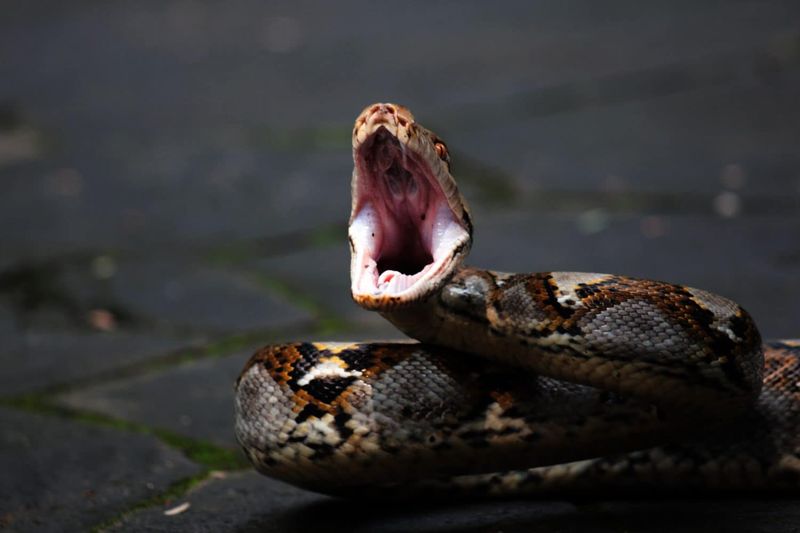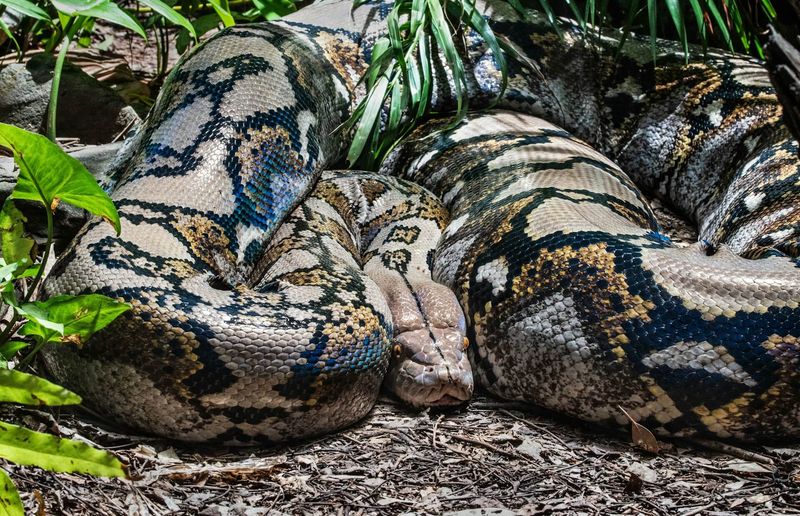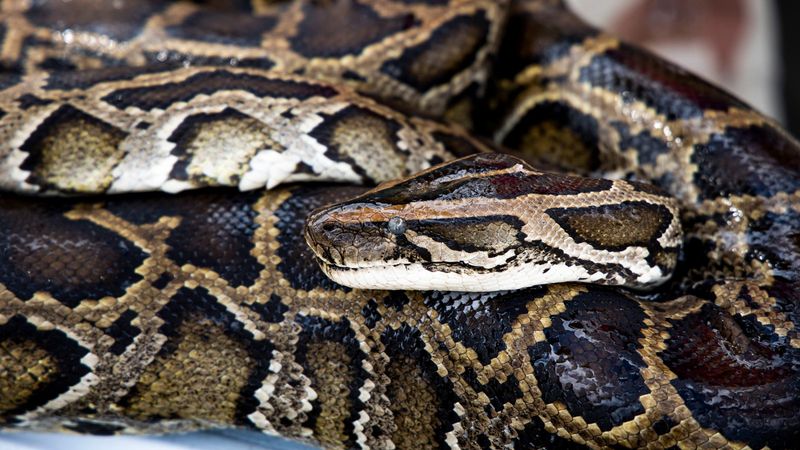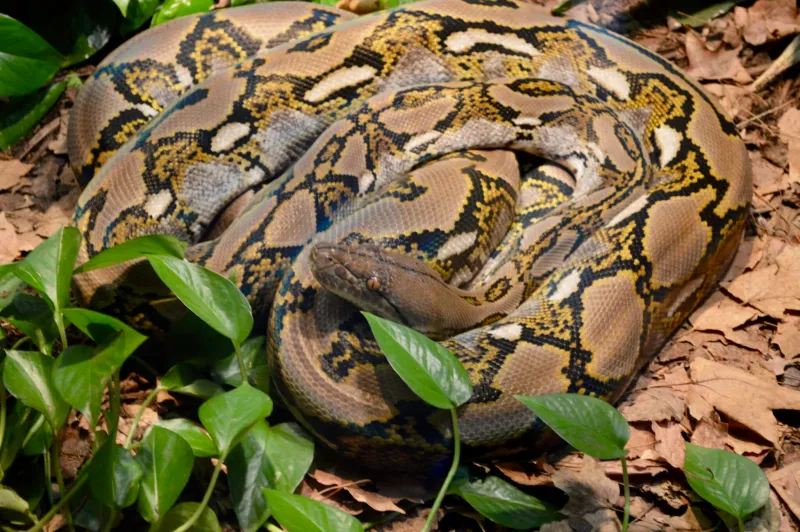Pythons have fascinated scientists and animal lovers alike with their extraordinary ability to consume and digest prey whole, including bones.
This incredible feat involves a complex interplay of biological processes that allow these reptiles to extract nutrients from their meals efficiently.
Exploring this phenomenon reveals not only the marvels of nature but also the unique adaptations that enable pythons to thrive in their environments.
Here, we delve into ten mind-blowing facts about how pythons manage this remarkable digestive process.
Flexible Jaw Mechanism

Pythons possess an astonishingly flexible jaw mechanism, allowing them to swallow prey whole. Unlike mammals, their lower jawbones are not fused together, enabling them to stretch and accommodate large meals.
This unique adaptation involves highly elastic ligaments and special joints that enhance mouth expansion. By moving each side of the jaw independently, pythons can walk their mouths over their prey.
This intricate design not only highlights nature’s ingenuity but also provides insight into the python’s hunting prowess. The mechanism ensures that they can tackle prey much larger than their head, a feat that continues to amaze researchers.
Powerful Digestive Enzymes

Inside the python’s stomach, powerful digestive enzymes work relentlessly to break down the entire prey. These enzymes are so efficient that they can dissolve tough bones and extract essential nutrients.
The python’s metabolism revs up significantly post-feeding, producing an intense rise in stomach acidity. This acidity, combined with specific enzymes, ensures the complete breakdown of the prey’s body.
The process is not only fascinating but vital for the python’s survival, allowing it to endure long periods without food. This efficient digestion means that pythons can thrive in environments with sporadic prey availability.
Adaptive Metabolism

After consuming a meal, a python’s metabolism undergoes a dramatic transformation. Their metabolic rate can increase by up to 44 times the normal rate to facilitate rapid digestion.
This metabolic surge is accompanied by a rise in body temperature, supporting enzyme activity. Amazingly, pythons can adjust this metabolic rate according to meal size and frequency. This ability to modulate energy expenditure ensures that they efficiently handle large, infrequent meals.
By conserving energy between feedings, pythons exhibit a masterclass in biological efficiency, showcasing their extraordinary adaptability in the wild.
Increased Heart Size

During digestion, a python’s heart can increase in size by up to 40%, enhancing blood flow to support the metabolic demands. This temporary enlargement aids in oxygen and nutrient distribution, crucial for processing large prey.
The phenomenon, known as cardiac hypertrophy, is reversible, returning to normal once digestion completes. This adaptability reflects the python’s remarkable ability to optimize its physiology for survival.
By temporarily boosting heart function, pythons ensure efficient nutrient absorption and energy use, a trait that continues to intrigue scientists studying cardiovascular adaptation in reptiles.
Bone-Dissolving Acidity

Pythons possess a stomach acidity potent enough to dissolve bones within days. Their gastric juices, rich in hydrochloric acid, create an environment where bones are effortlessly broken down.
This high acidity level is key to extracting calcium and other nutrients locked within skeletal structures. By efficiently disintegrating bones, pythons make use of every bit of their meal.
This astonishing ability not only supports their nutritional needs but also eliminates any waste, showcasing an impressive evolutionary adaptation. This bone-dissolving prowess highlights how nature equips these reptiles for survival against challenging odds.
Efficient Nutrient Extraction

The python’s digestive system is highly adept at extracting nutrients from prey, ensuring nothing goes to waste. Specialized enzymes breakdown proteins, fats, and carbohydrates with remarkable efficiency.
This process is complemented by a robust intestinal system that maximizes absorption. By converting their meals into a steady energy supply, pythons can survive extended periods between feedings. This efficiency is a testament to their evolutionary success, allowing them to thrive in diverse habitats.
The ability to fully utilize their meals highlights the python’s role as a resilient predator in the animal kingdom.
Slow Digestive Process

Unlike many animals, pythons take their time during digestion, a process that can last several days to weeks. This slow approach allows for thorough nutrient extraction and energy conversation.
The python’s digestive system adapts by slowing down between meals, conserving energy when food is scarce. This leisurely digestion supports their survival strategy, enabling them to consume large prey without rushing.
By embracing patience in their feeding habits, pythons reveal a fascinating aspect of their biology, emphasizing the intricate balance between energy intake and expenditure.
Thermal Regulation During Digestion

Post-feeding, pythons engage in thermoregulation by basking in the sun to elevate their body temperature. This behavior enhances digestive efficiency, accelerating the breakdown of food.
By optimizing warmth, pythons boost enzyme activity, ensuring rapid nutrient absorption. This thermal regulation is crucial in cooler environments, where maintaining a suitable body temperature becomes challenging.
By harnessing environmental heat, pythons enhance their digestive process, a strategy that underscores their adaptability. This reliance on external warmth reflects the python’s ingenious use of natural resources for survival.
Minimal Waste Production

Pythons are masters at minimizing waste, utilizing nearly all parts of their prey for nutrition. Their efficient digestive system ensures that only a small amount of waste is excreted, primarily consisting of uric acid.
This ability to maximize nutrient extraction and minimize waste production is an impressive evolutionary trait. By converting most of their meal into energy, pythons demonstrate a sustainable feeding strategy.
Their minimal waste production underscores their role as efficient predators, perfectly adapted to their ecological niche. This trait highlights the python’s remarkable ability to make the most of every meal.
Unique Digestive Pause

Between meals, pythons enter a state of digestive pause, significantly reducing metabolic activity. This intriguing adaptation allows them to conserve energy until their next feast.
During this pause, the python’s digestive organs shrink, returning to a baseline state. This ability to rapidly downscale their metabolism is essential for survival in environments with unpredictable food sources.
By effectively managing their digestive system, pythons exhibit an extraordinary level of control over their energy expenditure. This unique pause highlights their sophisticated survival strategy, making them one of nature’s most efficient hunters.

